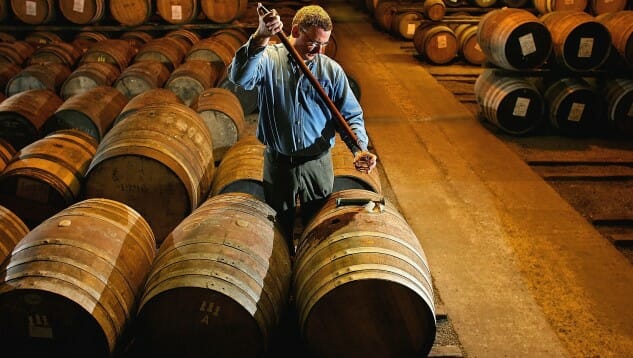How a Modern Whiskey Barrel Can (Theoretically) Be Used for 100 Years
Photos via Getty Images, Jeff J. Mitchell, Luke Sharrett
I had a realization, recently. Despite having become what an average person would likely refer to as “an expert” about brown liquor in the last five to 10 years, it struck me just how little I really knew about barrels themselves. Coupled with my increasing interest in scotch-style, malt whiskies, I began to seek out more information about the subtleties of how different kinds of barrels affect different kinds of spirits, when used in a variety of ways. And in the course of absorbing this new information, I came across something interesting: The art of barrel “rejuvenation.”
Suffice to say, the life of an oak barrel can be a long, fascinating thing. Although a barrel may very well be used just once, such as maturing an American bourbon or California cabernet before it’s recycled, others live on in secondary uses. The American craft beer industry obviously uses plenty of bourbon barrels, and has dipped a toe into every other dimension of barrel-aging as well. And the Scottish whisky industry could hardly exist at all, without the American whiskey industry to provide it with a steady supply of used barrels. But it’s a mistake to think that barrels can be used only twice. Or even thrice! The limits of a single barrel haven’t even been fully explored yet—there’s a possibility they could be in constant use for 100 years or more.
Allow me to explain how this is possible. But first, a little info on the wonder that is a whiskey barrel.
Barrels 101
Given the fact that the world is home to more than 60,000 species of tree, it is rather incredible to think that only oak wood is used in the construction of bourbon and scotch whisky barrels. There are several specific varieties of oak used for barrels—namely, American white oak (Quercus alba), French oak (Quercus robur, Quercus petraea), and to a far lesser extent Mongolian/Japanese oak (Quercus mongolica), but thanks to well-defined laws of what constitutes “bourbon” or “scotch,” no non-oak wood is used. Note, this does not apply to whiskeys hailing from regions such as Ireland, Canada and Japan, where woods such as maple, hickory or chestnut can also be used, although oak is still the vast majority.
Why oak? Well, these types of wood are uniquely suited to being made into barrels, in a variety of ways. Oak possesses the desired blend of malleability and toughness, to be bent into barrel staves. Properly stored, it can last many decades. And perhaps most importantly, oak is porous to exactly the right degree for aging spirits—it allows some air to be forced in and out of the wood grain as it “breathes,” which helps draw the liquid inside into the wood, where it extracts flavor and color. At the same time, oak forms enough of a protective barrier to not allow the spirit inside to become unpleasantly oxidized over the course of years. Without oak, we wouldn’t have modern bourbon or scotch as we know it.
But with that said, not all whiskey is entering into the same types of barrels. Here’s a brief breakdown of what kinds of oak barrels tend to be used in various industries:
Wine barrels: Oaken wine barrels come in a variety of sizes, but the primary thing that separates them from whiskey barrels is the degree to which their interiors have been exposed to heat. Rather than the “charred” interiors of a barrel intended for bourbon, oak barrels intended for wine are typically merely “toasted,” which is a lesser degree of heating that doesn’t result in the blackened, peeling appearance of a bourbon barrel interior. Toasting leaves more of the “oaky” flavors of the barrel intact, contributing a less intense profile of vanillans and caramel that are more desirable in whiskey.
Bourbon barrels: The U.S. definition of “bourbon” requires spirits labeled as bourbon to be aged in newly charred oak, although distilleries are free to choose from a variety of barrel sizes and char levels delivered by their cooperages—which is the industry term for the manufacturers of barrels. Most bourbon tends to find itself in barrels with the most popular “#3” or “#4” levels of char, but others do exist. The same is true for American rye whiskey as well. The majority of these barrels are the standardized, 53 gallon size—which means they’re significantly more than twice the size of the 15.5 gallon “half-barrel” beer kegs you partied with in college. Yes, the inconsistency in the term “barrels” across industries can be confusing.

Scotch barrels/casks: The vast majority of whisky in Scotland is aged not in newly charred oak barrels, but oak barrels previously used to mature American bourbon or other spirits such as sherry, port or wine. Most commonly, this involves the shipping of newly emptied bourbon barrels to Scotland, where they’re filled with newly distilled malt and grain whiskies. After aging in the American ex-bourbon barrels, they may be finished in other barrels (such as port or sherry, seeking specific flavors) before blending. It is commonly believed that used barrels contribute a subtlety that works well with the scotch malt whisky flavor profile, but experiments into using freshly charred oak are increasingly common in Scotland, if often viewed with an air of mistrust.
-

-

-

-

-

-

-

-

-

-

-

-

-

-

-

-

-

-

-

-

-

-

-

-

-

-

-

-

-

-

-

-

-

-

-

-

-

-

-

-








































